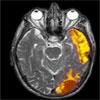
Changes in brain FDG metabolism induced by acupuncture in healthy volunteers.

Changes of glucose metabolism in specific brain areas following stimulation by acupuncture on LR3 and ST44 were documented using FDG-PET/CT.
Background: With the aid of newly developed functional brain imaging studies, studies are ongoing to see if acupuncture first acts on specific brain areas to induce effects on the human body.
Purpose: To examine if stimulation at specific acupuncture points changes brain glucose metabolism patterns, including the limbic system and specific brain areas related to the acupuncture effect in healthy volunteers using fluorodeoxyglucose positron emission tomography combined computed tomography (FDG-PET/CT).
Material and Methods: Twenty healthy volunteers (11 men and 9 women; mean age 49.1+/-7.3 years, age range 35-62 years) were included. Two sets of PET/CT scans were obtained from each volunteer, with and without stimulation by acupuncture. Two classic acupoints, LR3 (liver meridian) and ST44 (stomach meridian) were tested at the same time, using disposable sterile stainless steel needles. After initial acupuncture, the needle was kept in place without further stimulation. FDG-PET/CT scan of the brain began 45 min after FDG injection (185-222 MBq).
Results: After stimulation of LR3 and ST44 by acupuncture, glucose metabolism in the brain was increased in the left insula (BA 13), bilateral thalami, superior frontal region of the right frontal lobe, and the inferior frontal region of left frontal lobe compared with baseline. On the other hand, glucose metabolism was decreased after acupuncture in the cingulate and parahippocampal (BA 36) regions of the left limbic lobe.
Conclusion: Changes of glucose metabolism in specific brain areas following stimulation by acupuncture on LR3 and ST44 were documented using FDG-PET/CT.
Other News




